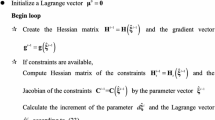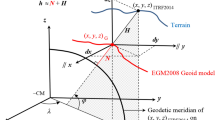Summary
The author makes a study of the classical methods of adjusting a triangulation. Use is made of the foundations and techniques of the method of least squares as developed byTienstra. The use of modern mathematical statistics and computing machines makes it not only possible to obtain a better appreciation of the results of observation and computation, but also to find a good practical solution.
The adjustment is divided into two main phases, the first of which is practically independent of the deviation of geoid and spheroid.
In section 4 some remarks are to be found with regard to the significance of Laplace's azimuth equation.
In section 6 the writer concludes that, in principle, a new adjustment of the continental triangulation is not necessary; use could be made of the adjustments of national triangulation already in existence; further, the writer pust forward the surmise that the assumption which is always mentioned in literature—that the reference ellipsoid and the geoid touch at the datum point—is not decisive.
Section 7 is devoted to the connection of ‘Füllnetze’.
Similar content being viewed by others
Abbreviations
- a :
-
superscript indicating observations made on the surface of the earth
- a :
-
semi-major axis of the spheroid
- f :
-
flattening of the spheroid
- φ:
-
latitude, north positive
- λ:
-
longitude, east of Greenwich
- h :
-
height above the spheroid
- θ:
-
deviation of the vertical
- ξ:
-
deviation in meridian, north positive
- η:
-
deviation in prime vertical, east positive
- ξ A :
-
component of deviation in azimuthA
- η A :
-
component of deviation in azimuthA+90°
- ν:
-
height of the geoid above the spheroid
- d :
-
orthometric height above the geoid (from spirit levelling)
- M :
-
radius of curvature in meridian
- N :
-
radius of curvature in prime vertical
- R :
-
√MN
- ε:
-
spherical excess of spheroidal triangle
- γ:
-
meridian convergence
- A :
-
azimuth, mostly of a geodesic
- b :
-
length of a base, reduced on the horizon
- τ:
-
enlargement in the base extension
- s :
-
distance along a geodesic
- r :
-
direction
- ζ:
-
zenith distance
- Z :
-
zenith
- η:
-
correction for skew normals (for heighth of the observed beacon) and for geodesic (for angle between normal section and geodesic)
- ln:
-
symbol for natural logarithm
- L :
-
auxiliary quantities, see section 2
- S :
-
auxiliary quantities, see section 2
- *:
-
superscript, see section 2
- \(\bar x\) :
-
(stochastic) quantity (or random variable, stochastic variable or variate). (Note: The author prefers the notation with an underscore, but for typographical reasons an overscore is used here.)
- x :
-
observation (or observed velue) of\(\bar x\)
- v x :
-
correction (or residual) ofx
- \(\tilde x\) :
-
mean of\(\bar x\)
- σ x :
-
standard deviation (or error) of\(\bar x\)
- σ xy :
-
amount of correlation (co-variance) of\(\bar x\) and\(\bar y\)
- \(g^{xx} = \frac{{\sigma _x^2 }}{{\sigma ^2 }}\) :
-
co-factor ofEquationSource % MathType!MTEF!2!1!+-% feaafiart1ev1aaatCvAUfeBSjuyZL2yd9gzLbvyNv2CaerbuLwBLn% hiov2DGi1BTfMBaeXatLxBI9gBaerbd9wDYLwzYbItLDharqqtubsr% 4rNCHbGeaGqiVu0Je9sqqrpepC0xbbL8F4rqqrFfpeea0xe9Lq-Jc9% vqaqpepm0xbba9pwe9Q8fs0-yqaqpepae9pg0FirpepeKkFr0xfr-x% fr-xb9adbaqaaeGaciGaaiaabeqaamaabaabaaGcbaGabmiEayaara% aaaa!3702!
- \(g^{xy} = \frac{{\sigma _{xy} }}{{\sigma ^2 }}\) :
-
co-factor of\(\bar x\) and\(\bar y\)
- σ2 :
-
variance (square of the standard deviation) of a quantity to which in the chosen system of weights the weight I would be given; indicated in abbreviation as variance of unit weight
- g xy :
-
weight of\(\bar x\) and\(\bar y\)
- Δx :
-
symbol for an unknown in the adjustment
- dx :
-
differential ofx
- \(E\left\{ {\bar x} \right\}\) :
-
symbol for the mathematical expectation (or expected value) of\(\bar x\)
- \(\hat \sigma ^2 \) :
-
estimation of σ2
- Δx :
-
symbol, see section 5
- I :
-
indication phase I or phase II
- II :
-
indication phase I or phase II
- P i :
-
no. of pointi
- []:
-
notation of a matrix
- B :
-
notation of a matrix
References
Tienstra, J. M. The foundation of the calculus of observations and the method of least squares.Bull. Géod., No. 10, 1948.
Tienstra, J. M. An extension of the method of least squares to correlated observations.Bull. Géod., No. 6, 1947.
Tienstra, J. M. Theory of the adjustment of normally distributed observations. Amsterdam, 1956.
Helmert.Die mathematischen und physikalischen Theorien der höheren Geodäsie. Leipzig, 1880. Part I, Chap. 12, paragraph 1.
Marussi, A. Bull. Géod., No. 19, 1951, p. 68.
Marussi, A. Bull. Géod., No. 24, 1952, p. 173.
Vening Meinesz, F. A. Bull. Géod., No. 21, 1951, p. 299.
Lambert, W. D. Bull. Géod., No. 3, 1947, p. 19.
Baeschlin, C. F. Lehrbuch der Geodäsie. Zürich, 1948, p. 290.
Weiken, K. C. R. Comm. géod. balt., Stockh., 1928, p. 109.
Ölander, V. R. Bull. Géod., No. 25, 1952, p. 339.
Jordan-Eggert.Handbuch der Vermessungskunde III, 2, 1941, pp. 422–434.
Dwyer, P. S. Linear computations. New York and London, 1951, Chap. 17.
Tienstra, L. Bull. Géod., No. 6, 1947, p. 327.
Ölander, V. R. Ausgleichung einer Dreieckskette mit lauter Laplaceschen Punkten. Helsinki, 1927.
Baeschlin, C. F. Bull. Géod., No. 52, 1936, p. 425;Lehrbuch der Geodäsie. Zürich, 1948, p. 297.
Kneissl, M. Z. Vermessungsw., 1940, p. 337; 1942, p. 233.
Roelofs, R. Bull. Géod., No. 6, 1947, p. 343.
Ledersteger, K. Z. Vermessungsw., Wien, 1949.
Vening Meinesz, F. A. Bull. Géod., No. 15, 1950, pp. 32, 43.
Vening Meinesz, F. A., Baeschlin, C. F. andHotine, M. Bull. Géod., No. 19, 1951, p. 61.
Baeschlin, C. F. Bull. Géod., No. 24, 1952, p. 251.
Vening Meinesz, F. A. Bull. Géod., No. 27, 1953, p. 75.
Tienstra, J. M. Bull. Géod., No. 6, 1947, p. 316.
Wolf, H. et al. Veröff. Inst Erdmess., Bamberg, 1949–52.
Wolf, H. et al. Veröff. Inst. Erdmess., Bamberg, No. 6, 1949.
Ledersteger, K. Z. Vermessungsw., Wien, 1949, Sonderheft 8.
Ledersteger, K. Z. Vermessungsw., Wien, 1952, p. 174; 1953, p. 97.
Wolf, H. Bull. Géod., No. 21, 1951, p. 307.
Baeschlin, C. F. Lehrbuch der Geodäsie. Zürich, 1948, p. 287.
Handleiding voor de technische werkzaamheden van het kadaster (Manual for technical activities of the cadastral service in the Netherlands). 's-Gravenhagen, 1956.
Author information
Authors and Affiliations
Rights and permissions
About this article
Cite this article
Baarda, W. Some remarks on the computation and adjustment of large systems of geodetic triangulation. Bull. Geodesique 43, 20–49 (1957). https://doi.org/10.1007/BF02527245
Published:
Issue Date:
DOI: https://doi.org/10.1007/BF02527245




